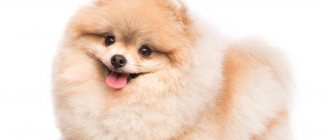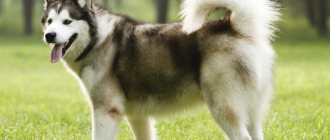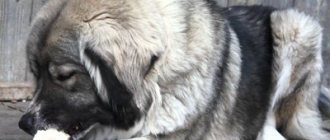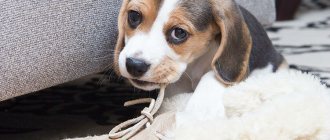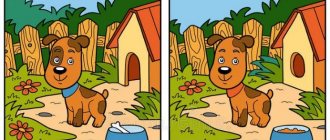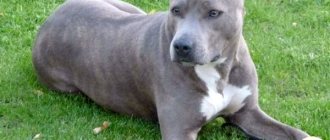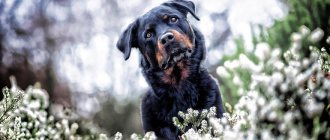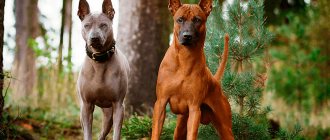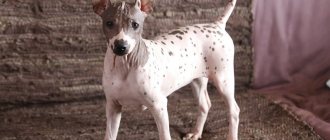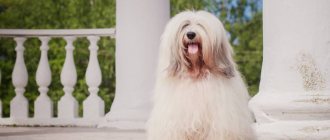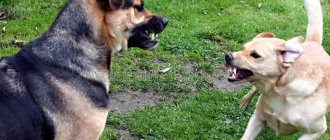Origin of the breed
The history of the breed is connected with the life of the ancient Malamute tribe. These are the native people of Alaska who were engaged in hunting and fishing. They bred these strong and hardy animals for their needs. At the end of the 19th century, this dog breed was on the verge of extinction. When the gold rush began, prospectors indiscriminately crossed Malamutes with smaller breeds. The number of purebred Malamutes has decreased sharply. The situation was leveled out only in the 20s of the 20th century, when American dog handlers began to actively renew the breed.
During the war, the number of representatives of this breed again decreased to a critical figure: experts counted 30 individuals. In the post-war period, measures were taken, as a result of which the population not only recovered, but also received worldwide recognition. In 1966, the International Canine Federation approved the breed standard for the Alaskan Malamute, which is still valid today. Currently, Malamutes are among the twenty most sought-after dogs in the world and are a symbol of Alaska.
Initially, the Malamute was intended to guard homes, transport goods and participate in dog fights. Gradually, the fighting and guarding qualities of this breed were lost, and it became exclusively a sled dog.
History of the Alaskan Malamute breed
The Alaskan Malamute breed has always been close to people. Its history goes deep into the past. It is known that the Alaskan Malamute breed lived with the ancient Eskimo tribe. Strong and resilient, Malamutes served as a means of transportation for northern peoples for many centuries. Scientists have proven that in ancient times this breed was larger and stronger compared to today's dogs.
Alaskan Malamutes got their name from the Malemute tribe. The tribe led a nomadic lifestyle, so people needed a hardy, large dog.
There is a version about the origin of this breed. It says that ancient Malamutes have been bred since the Ice Age. Modern Alaskan Malamutes are very different from their ancient ancestors.
During the gold rush, Malamutes greatly increased in price due to their qualities. Unfortunately, in those difficult times only a few remained of this breed. People recklessly began crossing them with other northern dogs that were much smaller than Malamutes.
Historical fact
In 1925, a diphtheria epidemic began. Medicines were urgently needed. The dogs were harnessed to sleds and sent for vaccines. Alaskan dogs overcame blizzards and storms. A film was made about these dogs and a monument was erected to them in New York City.
Thanks to this, many learned about this brave breed. This is how Alaskan Malamutes came to Europe. In 1935, the first club of lovers of this breed was created and in the same year the official standard was created.
Today, in the top 30 smartest dogs in the world, Alaskan Malamutes occupy a respectable 18th place. Since 2010, this breed has become the official symbol of the United States.
Types of Malamutes
There are two types of Malamutes. One species, called m-loot, is more impressive in size compared to its relatives. The second - Kotzebue - is distinguished not only by its smaller size, but also by its more flexible character. The species differ in color: the Kotzebue is gray, the M-lut can be white, black and white or blue. Breeders do not have a consensus on which species is real and which is secondary. The only thing everyone agrees on is that both species meet the breed standard.
At the turn of the 20th and 21st centuries, a new breed was developed - the Wolamute, a cross between a Malamute and a wolf. The hybrid inherits the physical qualities of a wild animal, but such individuals are not recommended to be kept and raised at home.
Advantages and disadvantages
Positive sides:
- Guard qualities. With Tibetan Mastiff roots, the dogs are predisposed to guard. They know their owners and their associates well, they are aggressive towards strangers, but will not cause harm.
- Suitable for aviary and outdoor keeping. Due to their thick and long coat, Chinese Malamutes are not afraid of frost and can easily endure winters.
- Balanced character. Dogs of this breed are calm, not aggressive and get along well with children and other animals.
- Mental capacity. Dogs are developed, intelligent and easy to train. They feel weak people and stop obeying them. Therefore, they are recommended only for experienced dog breeders.
Negative sides:
- Care. Since the dog has long and thick hair, it is necessary to keep an eye on it. This takes a lot of time.
- Stubbornness. Chinese Malamutes can be mischievous, and sometimes you have to negotiate with them. At the same time, you need to show strength of character and stand your ground to the end, then the dog will show respect for the owner.
- Digging holes. In ancient times, the ancestors of Malamutes ate burrowing animals; this habit was passed on to modern dogs. Therefore, if you keep an animal in a private house on the street, you need to be prepared for constant holes in the yard.
- Expensive to feed. Dogs are of impressive size and therefore need to be fed in fairly large portions. Quality food will cost a pretty penny.
Description of the breed
The Alaskan Malamute is the largest sled dog species. An adult male weighs 40 kg, a female weighs less, up to 38 kg. The size of an adult dog is impressive: the height at the withers of a male reaches 63 cm, the height of a female is 57-59 cm. The characteristics of the breed include the presence of powerful and well-developed paws, similar to those of a bear. Weak limbs are considered a deviation from the standard. The dog's ears are triangular with rounded tips and set wide apart. The eyes are slightly slanted and brown. There are individuals with blue eyes, but this is considered a serious defect.
The appearance of these dogs suggests that they are designed to work in difficult conditions. Their head and muzzle are large, and their nose must be black. The exception is red dogs; their noses may be brown. The bite is scissor bite and the jaws are strong and well formed. The Malamute is a long-haired species. His coat is hard, with a thick and soft undercoat, which perfectly protects him from hypothermia.
The most common colors of Malamutes:
- black and white;
- sable;
- grey-white.
There are dogs of red and white color. The only solid color allowed by the standard is white.
Malamute and husky
People who do not understand the intricacies of canine breeds confuse Malamute and Husky. Outwardly they are really similar. But in terms of character and basic working qualities, these two breeds differ from each other:
- Huskies have a softer and more flexible disposition compared to Malamutes.
- The Malamute is stronger and more resilient than the Siberian Husky. It can travel a huge distance with a heavy load. Huskies cannot handle such loads.
- Huskies are more agile and their speed abilities are higher than those of Malamutes. Thanks to these qualities, Huskies participate in speed competitions.
- Malamutes should not have blue eyes, but huskies have blue eyes.
- Huskies are energetic, love to frolic and, unlike their Alaskan counterparts, always want to be leaders. Malamute doesn't need this. It is enough for him that people communicate with him and love him.
You can distinguish a husky from a malamute by size; the former are smaller. Eye color will also help distinguish these dogs from each other: blue eyes indicate a Siberian. The Malamute's head is large and voluminous, while the Husky's is narrow and neat. There are also noticeable differences in the skeletal structure of dogs: the Malamute has stronger and larger bones. You can distinguish a husky puppy from a malamute by eye color, color and head shape. Both breeds are good, with any choice a person will not go wrong. Both of them faithfully serve their masters, love children and help people.
Malamute breed standard
What is a Malamute? The description of the breed is as follows. The trait that distinguishes Malamutes - dogs of this breed - is developed muscles and large bones, because of which they are very similar in appearance to wolves. This is an exceptionally strong and at the same time agile sled dog. Despite her rather impressive build, she is quite compact; the animal's body is covered with thick and coarse hair; the undercoat is soft. Breed characteristics:
- The height at the withers of males ranges from 58 to 60 cm (for females) and from 60 to 64 cm (for males).
- The animal's head is large, but at the same time proportional to the body in size. The muzzle is also voluminous, but it is not elongated and does not have a pointed shape.
- The dog is distinguished by powerful jaws, large and sharp teeth, and a scissor bite. The lips are tightly closed.
- The animal's eyes are set slightly askew; they are almond-shaped and most often brown. Size is medium.
- The dog's triangular ears are elegant, erect, and slightly rounded at the ends. They are located far from each other.
- The nose is most often colored black; the only exception is the red Alaskan Malamute (their nose has a brown tint).
- The dog's strong, slightly arched neck gives it a special grace.
- The chest is quite wide. The back is straight, the lower back is strong and muscular. The tail, when at rest, rises above the animal's back.
- The Alaskan Malamute's coat is one of the animal's most distinctive features. Since this dog first inhabited the northern territory, it is moderately tough, but at the same time it has a rather soft fluffy undercoat and is a little oily (this feature should protect the dog from hypothermia and makes it waterproof). Long-haired Malamute.
- Smooth, parallel limbs in appearance slightly resemble bear paws. The bone is wide, the muscles are well developed.
- Acceptable coat color ranges from gray and sometimes bluish to white and black.
- The Malamute girl is different in that her first heat begins between eight months and a year.
Varieties
Today there are two main varieties of the breed - M'Lut and Kotzebue. Despite the fact that experts have not yet figured out which variety has the best qualities, each of them within the species has its own advantages and disadvantages.
And also, Canadian, Caucasian, English, American, and Siberian Malamutes can be classified into a separate category. Each line has its own characteristics. For example, Canadian dogs are characterized by extremely low aggressiveness, while Asian (in particular Siberian) dogs demonstrate high affection for children. The physically strongest malamutes live in Yakutsk; Altai has become home to the largest individuals of this breed.
M'Luth
Size and weight
Considering how much an adult dog should weigh, we note that the body weight of the animal as a whole depends on gender: the standard norm for females is 34 kg, while for males it is slightly larger and amounts to 38 kg. The average height of a male is 63–64 cm, a female is 58–59 cm.
Color and coat type
The nature of coat color is influenced primarily by the characteristics of the intrabreed line. For example, the M'Lut line has colors such as black and white, brown and white, white and red, and even blue. The Kotzebue line has a gray “wolf” color.
Kotzebue
Character
The appearance of the Alaskan Malamute scares away uninvited guests. In fact, the formidable appearance hides an affectionate and friendly disposition. The dog is never aggressive and is calm about the appearance of strangers on its territory. She is too kind and trusting, this prevents her from being a strict guard. However, this dog has a complex and freedom-loving character. From the very beginning, she should be taught that the owner is the leader, and she must obey him unquestioningly.
The Malamute is a pack dog that does not know how to live alone. This instinct has been preserved in her since ancient times and strengthened over many years of riding in a harness. These dogs love active games and fun, and also attract attention to themselves. That's why Malamutes and children always get along well and play. But they do not get along well with other pets.
Malamutes bark very rarely; they mostly make a sound similar to a purr. Their inability to bark is explained by their origin from wolves. Representatives of this breed rarely grow up to be angry and aggressive dogs. This happens when a dog is raised incorrectly or is cruel to it.
Dog character
With proper training, there will be no problems with the Alaskan Malamute. For the most part, these are good-natured dogs that are easy to train. The characteristics of this breed are boundless curiosity and love of humanity. A malamute will never leave its owner in trouble.
As for living together with other breeds, it is quite acceptable. But you need to take into account that the Malamute is by nature a leader and leader, so the dog will force all surrounding animals to live by its rules. If they agree, there shouldn't be any problems. It can be difficult with cats who are not particularly eager to live by someone else’s rules. But with the right approach on the part of the breeder, cohabitation is quite possible.
A person who has decided to get himself an Alaskan Malamute puppy must take into account that this dog will not be considered to have a strong enough character. If the breeder constantly shows his weakness, he will not be able to raise the Malamute correctly. In turn, this can be very dangerous. Dogs of this breed are very large and powerful, so if the animal is uncontrollable, this can lead to serious problems.
The Alaskan Malamute is endlessly loyal to its owner. But he will consider as such only a person with a strong character, that is, a leader who can prove that he is smarter, more cunning and stronger than his dog. Training a dog of this breed will take some work. Beginners will not be able to train a Malamute; this requires the hand of a professional. It is especially difficult to teach a dog simple commands, since representatives of this breed really do not like monotonous work. They perform standard tasks only out of great love for their master.
The Alaskan Malamute is a dog with enormous working and physical potential. This breed is not intended to be kept in an apartment, as it needs frequent exercise, which is impossible to obtain in an urban environment. An exception may be bikejoring, that is, using the strength of a dog to move a bicycle. Malamutes in harness must run about 10 km a day. In this case, the animal will be happy and healthy.
Care
Malamutes are clean dogs, they have no smell. It is recommended to wash them every two months. They love to swim, so the owner will not have problems with bath procedures. Their nails are trimmed once every 14 days. Also, the owner should constantly check the oral health of his pet and brush his teeth several times a week.
Grooming for representatives of this breed is complicated by their thick coat. It needs to be washed often and combed well. And during molting, it is necessary to comb out the fluff so that the pet does not develop tangles and pieces of fur do not fly around the house.
Feeding the Alaskan Malamute
You can feed your Alaskan Malamute dry food or natural food. Natural feeding should be balanced. It is difficult to maintain a balance, so it is recommended to add vitamins to food.
You can start feeding your puppy natural food from 1 month. It could be:
- beef, lamb, turkey, chicken;
- rice or buckwheat;
- goat milk and cottage cheese.
At 2 months the puppy is given additional food:
- vegetables (carrots, zucchini);
- fruits (apple, banana);
- sea fish fillets can be given, but not more than 2 times a week;
- It is useful to add 1 teaspoon of olive oil to food;
- drinking water must be fresh, clean and cool, and located in a certain place.
An adult dog is fed once a day. Until 4 months of age, the puppy is fed 3 times a day. After 6 months, the puppy begins to be fed 2 times a day. For this breed, the main food is raw meat. This is what their ancestors ate.
Despite its large size, the northern dog eats little. The most important thing is not to overfeed her. This can lead to pet obesity and, as a result, problems with the limbs.
Dry food must be premium, luxury or holistic. You need to pay attention to the ingredients in the food. Desirable dry food ingredients: chicken, beef, lamb (60%).
Content
The best way to keep a Malamute is an aviary in the courtyard of a private house. Keeping a dog in an apartment is possible, but not advisable: the Malamute needs space and daily long stays in the fresh air. You can build an enclosure with your own hands or purchase a ready-made one. A booth is installed in it; its dimensions depend on the size of the dog. In general, it is recommended to adhere to the following parameters:
- the booth is built 80 cm high and 100 cm long;
- the height of the entrance hole should be 5 cm less than the height of the dog;
- The width of the entrance should be 5 cm wider than the dog's chest.
The enclosure for a Malamute should not be closed; the dog feels lonely in it. In such cases, she begins to howl. To wean your Malamute from howling, you need to leave him alone as little as possible. You can put something in his enclosure that smells like home and his owners, so that he won’t feel so sad about staying in the cage at night. Sometimes dogs howl from excess energy that has nowhere to be spent. In such cases, you need to increase physical activity on your pet. The main building material for building an enclosure should be wood, since Malamutes are very sensitive to toxic components of plastic and paints.
Nutritional Features
The Malamute's diet does not depend on its size. The huge dog eats less than representatives of other similar large breeds. At home, it is preferable to feed the dog natural food. The diet of a puppy and a dog should mainly consist of meat, cottage cheese, sometimes fermented milk products, cereals, chicken eggs, and vegetables. If it is not possible to prepare natural food, it is recommended to use dry food. This is better than feeding the dog dishes from the master's table.
Experts recommend feeding your dog twice a day. Eating one meal at a time can lead to volvulus. 4-month-old puppies are fed three times a day, from this age they are transferred to two meals a day. A dog always needs clean water.
Dog owners know that Malamutes have a bad habit of stealing food. To avoid health problems for your pet, you need to get rid of it.
Training and education
Malamute training begins immediately after purchasing a puppy. When choosing a pet of this breed, you should remember that by nature they do not tend to obey; they are independent and stubborn dogs. But if the owner manages to gain authority, she will obey. Training at home should take place without putting pressure on the dog. The Alaskan Malamute is a smart dog; he will not carry his owner’s slippers ten times. He may regard such a command as disrespect for himself and will not obey. The dog needs active physical activity. It is better to hire a professional dog trainer to show you how to train puppies.
The best exercise for sled dogs is towing a sled, empty and loaded, with the owner standing on skis. They are usually happy to complete this task. Next, the dogs are taught to choose the right direction in the sled. To do this, use the left and right commands. After the command is given, you should pull the leash in the right direction, suggesting the right direction. After correctly executing a command, your pet should be praised and treated with something. You cannot force a dog to carry out one command more than two times in a row, otherwise it will lose interest in it and stop obeying.
You can train a puppy to pull a sled in which a person sits only when its skeletal system is sufficiently strong.
For training to be as effective as possible, your pet must be trained regularly. There is no point in teaching a dog to guard territory. Representatives of this breed are unsuitable for this task. You should raise your dog in a friendly and strict manner at the same time. Physical force and rude shouting must not be used. Once you lose your pet's trust, it will be difficult to regain it.
Nicknames for dogs
The dog must respond to its name, this is also one of the commands. The nickname should be short and easy to pronounce, so the pet will remember it easier. Choosing a name for an Alaskan Malamute should be approached with all responsibility. Experienced dog handlers advise:
- When choosing a nickname, you should take into account the size of the pet. A diminutive for a big dog sounds ridiculous.
- Malamutes can be called by color: Sable, Red, Black.
- The nickname can reflect the harsh natural conditions in which the Malamute lives: Hurricane, Snowball, Buran.
- Nicknames for boys can be borrowed from films, toponymic terms: Viking, Oscar, Brutus, Kazbek, Nord, Danube.
- Nicknames for girls are usually chosen so that there are two syllables that go well together: Dina, Eva, Lizzie, Rada, Nora.
The name of an animal cannot be changed at will. It is given once and for all.
Health
Alaskan Malamutes are strong and hardy animals. Average life expectancy is 12 years. Sometimes there are long-livers who reach the age of 17. With proper care and healthy parents, problems rarely arise.
Diseases
Some dogs suffer from:
- hemeralopia (night blindness);
- progressive retinal atrophy;
- hypothyroidism.
The greater weight of an adult Malamute also causes inconvenience. Because of it, joint diseases appear. Excess body weight only makes the situation worse.
Vaccinations
An Alaskan Malamute puppy needs the same vaccinations as other breeds. Vaccination is carried out at the age of:
- 7-8 weeks;
- 10-12 weeks;
- 6 months.
In the future, animals are revaccinated annually. The veterinarian can adjust the vaccination schedule based on the Alaskan Malamute's immunity and the presence of common diseases in a particular area.
Diseases and life expectancy
Life expectancy does not exceed 15 years. These dogs, like other domestic animals, are susceptible to certain diseases. They suffer most from the following diseases:
- disorders of the development of cartilage tissue, which lead to weakening of joints;
- gastric volvulus;
- retinal atrophy;
- adenocarcinoma of the anus;
- disorders in the musculoskeletal system.
Alaskan Malamutes also have nasal pigmentation disorders and hemeralopia.
Health and Diseases of the Alaskan Malamute
Possible diseases
Alaskan Malamutes are very hardy.
They easily tolerate harsh climate conditions. But they are still susceptible to some diseases. They may exhibit neurological disorders affecting the peripheral nervous system – polyneuropathy. They are susceptible to diseases such as hip dysplasia, anal adenocarcinoma (malignant tumor), diabetes, and hemophilia. They are also prone to dermatological diseases such as atopic dermatitis and demodicosis. Less common eye diseases are: progressive retinal atrophy, cataracts, hemeralopia (day blindness), glaucoma.
To improve the health of an Alaskan, it is important to vaccinate him every year. Once a quarter it is necessary to do prophylaxis against worms, at least once every two weeks to clean the pet’s ears, brush the fur and teeth. In the warm season, you need to give a special anti-tick remedy.
Compared to other breeds, Alaskans are long-lived. Many of them live up to 16 years.
Reproductive health
Malamute bitches begin to come into heat around the age of one year.
If the first estrus was noted before 7 months of age, you need to contact a veterinarian, this may be bleeding. There is no need to rush into mating: a female can become pregnant normally only on her third estrus, that is, about 20 months. Males are bred no earlier than they reach two years of age.
Before going into heat, a dog can behave strangely: its character deteriorates, it becomes overly stubborn and restless. In addition, estrus occurs once every six months and lasts 20 days: in this case, the discharge from the loop is very abundant. This can be a problem for some owners, so unless you plan to breed, it is best to have your female Malamute spayed.
Mating
According to experienced dog breeders, mating of Malamutes should occur when the male is 24 months old and the female is 20 months old. It is not recommended to breed dogs at a younger age, as this is a big burden for their fragile bodies. Knitting can be freestyle or manual. With freedom, the process occurs naturally. If the bitch is inexperienced, the dog owner helps them by first putting a muzzle on the bitch.
During pregnancy, physical stress on the bitch should be reduced. To give birth to puppies, you need to prepare a place for the dog and let her get used to it. At the moment when labor begins, you need to be close to the dog, distract it, and surround it with affection. Once the puppies arrive, it is best to leave the bitch alone. After the birth of the offspring, it is also better not to approach them at first. The mother should be allowed to feed and wash the puppies in peace. Then it will be possible to toilet the dog and examine the puppies.
How to buy a puppy
It is better to buy puppies from reliable breeders with a good reputation. The price depends on several factors. Malamute puppies that do not have a noble pedigree will cost 10,000 or 12,000 rubles. A puppy from titled parents costs from 15,000 to 30,000 rubles. Children from champion parents are more expensive.
When purchasing a pet that looks more like a plush toy, you should carefully examine it and assess its condition. A healthy puppy is active and cheerful. Kennels where you can buy Malamute: Alveig, Mal Planet, From Konev-Bor.
